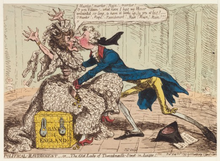Bank Restriction Act 1797
| Act of Parliament | |
 37 Geo. 3. c. 45 | |
| Dates | |
|---|---|
| Royal assent | 3 May 1797 |
| Expired | 2 December 1797 |
| Other legislation | |
| Repealed by | Statute Law Revision Act 1871 |
Status: Repealed | |
| Act of Parliament | |
 38 Geo. 3. c. 1 | |
| Dates | |
|---|---|
| Royal assent | 30 November 1797 |
| Text of statute as originally enacted | |
The Bank Restriction Act 1797 was an
Reasons for restricting
An increasing number of people were trading their
Reasons for overprinting
British banknotes were overprinted by the government of William Pitt the Younger after Britain declared war on revolutionary France in 1793.[5] The Bank Restriction Act released the government from the fear of mass redemption of such convertible banknotes, and by the end of the war in 1814 the banknotes in circulation had a face value of £28.4 million, yet were backed by only £2.2 million of gold. However, by 1821, and with radical economic policies instigated by Sir Robert Peel (the future Prime Minister, acting as Chairman of the Bullion Committee), this situation was reversed, and with £2,295,360 of notes in circulation being backed by £11,233,390 of bullion,[3] the British government resumed "convertibility" on 1 May 1821 (two years ahead of schedule).
In popular culture

After the passing of the act,
See also
- Peel's Bill
- Inflation
- Depreciation
Further reading
- Patrick K O'Brien, Nuno Palma, Danger to the Old Lady of Threadneedle Street? The Bank Restriction Act and the regime shift to paper money, 1797–1821, European Review of Economic History
References
- ^ "Bank Restriction Act of 1797". Investopedia. Retrieved 10 March 2007.
- ^ "Mark Crosby, "The Bank Restriction Act (1797) and Banknote Forgery" | BRANCH". Retrieved 14 October 2022.
- ^ ISSN 0362-4331. Retrieved 14 October 2022.
- JSTOR 25108102.
- ^ "England". University of Pennsylvania. Archived from the original on 11 February 2007. Retrieved 10 March 2007.
- ^ "Mark Crosby, "The Bank Restriction Act (1797) and Banknote Forgery" | BRANCH". Retrieved 14 October 2022.
